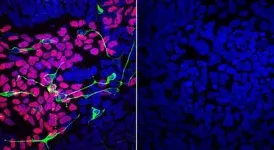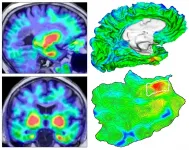Squid-inspired robot swims with nature's most efficient marine animals
2021-01-20
(Press-News.org) Scientists at the University of Southampton and University of Edinburgh have developed a flexible underwater robot that can propel itself through water in the same style as nature's most efficient swimmer - the Aurelia aurita jellyfish.
The findings, published in Science Robotics, demonstrate that the new underwater robot can swim as quickly and efficiently as the squid and jellyfish which inspired its design, potentially unlocking new possibilities for underwater exploration with its lightweight design and soft exterior.
Co-author Dr Francesco Giorgio-Serchi, Lecturer and Chancellor's Fellow, at the School of Engineering, University of Edinburgh, said: "The fascination for organisms such as squid, jellyfish and octopuses has been growing enormously because they are quite unique in that their lack of supportive skeletal structure does not prevent them from outstanding feats of swimming."
The "cost of transport" is used to compare efficiencies of species across biology, and by this measure the jellyfish is the most efficient animal in nature, easily beating running and flying animals and bony fish.
The new robot was developed at the University of Southampton and is the first submersible to demonstrate the benefits of using resonance for underwater propulsion. Resonance refers to large vibrations that occur when applying a force at the ideal frequency, like pushing a child on a swing. This allows the robot to use very little power but generate large water jets to push itself forward.
The simple but effective mechanism consists of rubber membrane enclosing eight 3D-printed flexible ribs, which together form a 'propulsive bell'. A small piston in the top half of the robot taps this bell repeatedly so that it expands and then springs back. This mimics a jellyfish's swimming technique and produced the jets of fluid to propel the robot through the water. When the piston operates at with the correct frequency - the natural resonance for the components - the robot can move at one body length per second and match the efficiency of the Aurella aurita jellyfish.
The latest tests show the new robot is ten to fifty times more efficient than typical small underwater vehicles powered by propellers. This increased efficiency, combined with the additional benefits of the robot's soft, flexible exterior would make it ideal for operating near sensitive environments such as a coral reef, archaeological sites, or even in waters crowded with swimmers.
Co-author Thierry Bujard, a Masters student in Naval Architecture at the University of Southampton, designed and built the robot in a matter of months. Thierry said, "Previous attempts to propel underwater robots with jetting systems have involved pushing water through a rigid tube but we wanted to take it further so we brought in elasticity and resonance to mimic biology. I was really surprised by the results, I was confident that the design would work but the efficiency of the robot was much greater than I expected."
Dr Gabriel Weymouth, Associate Professor in the University's School of Engineering, who supervised the project added, "The great thing about using resonance is that we can achieve large vibrations of the propulsive bell with a very small amount of power; we just need to poke it out of shape and let the elasticity and inertia do the rest. This has allowed us to unlock the efficiency of propulsion used by sea creatures that use jets to swim.
"The last decade has seen a surge in research into flexible and biologically-inspired robots, such as Boston Dynamic's "Big Dog", because they can be much more versatile than standard industry robots. This research demonstrates that these concepts can also be applied to underwater robotics.
"There are still many challenges and exciting possibilities to explore with soft underwater robotic technologies. We are now looking to extend the concept behind this robot to a fully manoeuvrable and autonomous underwater vehicle capable of sensing and navigating its environment."
INFORMATION:
Notes to editors
An explainer video and raw footage can be downloaded at the following links, please credit to University of Southampton.
Explainer video
Raw footage of robot
Raw footage showing design
"Cost of Transport" refers to the ratio of the power spent on propulsion divided by the weight and speed of the animal: power/[weight*speed]
For further information and interview requests, please contact the University of Southampton's Media Relations Office: Steve Bates - s.d.bates@soton.ac.uk; 07342 060429
The study "A resonant squid-inspired robot unlocks biological propulsive efficiency" will be published in Science Robotics. A copy of the paper, can be found online at the Science Robotics press package at http://www.eurekalert.org/jrnls/scirobotics/ or by sending an email to robopak@aaas.org
ELSE PRESS RELEASES FROM THIS DATE:
2021-01-20
Researchers at the National Institutes of Health have discovered a new genetic disorder characterized by developmental delays and malformations of the brain, heart and facial features. Named linkage-specific-deubiquitylation-deficiency-induced embryonic defects syndrome (LINKED), it is caused by a mutated version of the OTUD5 gene, which interferes with key molecular steps in embryo development. The findings indicate that the newly identified pathway may be essential for human development and may also underlie other disorders that are present at birth. The information will help scientists better understand such diseases--both common ...
2021-01-20
Researchers have developed an automated method that can track the development of harmful clumps of TAU protein related to Alzheimer's disease in the brain, according to work involving 443 individuals. The method revealed that TAU primarily emerged in an area of the brain called the rhinal cortex before spreading elsewhere, suggesting that targeting TAU here could potentially slow the progression of Alzheimer's disease. The buildup of toxic amyloid-beta and TAU proteins is responsible for many of the symptoms and damage to neurons seen in Alzheimer's disease. However, current therapies have shown reduced efficacy, at least in part because the therapies were administered long ...
2021-01-20
A new Northwestern University study reaffirms the importance of getting a good night's sleep.
By examining fruit flies' brain activity and behavior, the researchers found that deep sleep has an ancient, restorative power to clear waste from the brain. This waste potentially includes toxic proteins that may lead to neurodegenerative disease.
"Waste clearance could be important, in general, for maintaining brain health or for preventing neurogenerative disease," said Dr. Ravi Allada, senior author of the study. "Waste clearance may occur during wake and sleep but is substantially enhanced during deep sleep."
The ...
2021-01-20
Rubbing against catnip and silver vine transfers plant chemicals that researchers have now shown protect cats from mosquitoes. The results also demonstrate that engaging with nepetalactol, which the study identified as the most potent of many intoxicating iridoid compounds found in silver vine, activates the opioid reward system in both domesticated felines and big jungle cats. While nepetalactol had been previously identified, these studies directly illuminate its extremely potent effect on cats. And by revealing the biological significance of well-known feline behaviors, ...
2021-01-20
Methamphetamine overdose deaths surged in an eight-year period in the United States, according to a study published today in JAMA Psychiatry. The analysis revealed rapid rises across all racial and ethnic groups, but American Indians and Alaska Natives had the highest death rates overall. The research was conducted at the National Institute on Drug Abuse (NIDA), part of the National Institutes of Health.
Deaths involving methamphetamines more than quadrupled among non-Hispanic American Indians and Alaska Natives from 2011-2018 (from 4.5 to 20.9 per 100,000 people) overall, with ...
2021-01-20
BOSTON -- While deaths related to heart disease have declined among older people, studies suggest that death rates among younger patients have remained stagnant or increased slightly. To understand what factors put younger individuals at higher risk of premature coronary heart disease (CHD), researchers from Brigham and Women's Hospital and the Mayo Clinic analyzed more than 50 risk factors in 28,024 women who participated in the decades-long Women's Health Study. Notably, women under 55 with type-2 diabetes had a tenfold greater risk of having CHD over the next two decades, with lipoprotein insulin resistance ...
2021-01-20
Over the past 20 years, scientists have been developing metamaterials, or materials that don't occur naturally and whose mechanical properties result from their designed structure rather than their chemical composition. They allow researchers to create materials with specific properties and shapes. Metamaterials are still not widely used in everyday objects, but that could soon change. Tian Chen, a post-doc at two EPFL labs - the Flexible Structures Laboratory, headed by Pedro Reis, and the Geometric Computing Laboratory, headed by Mark Pauly - has taken metamaterials one step further, ...
2021-01-20
What The Study Did: This observational study examined how COVID-19-related government-mandated closures and restrictions were associated with changes in mobility and the spread of COVID-19 in Nigeria.
Author: Daniel O. Erim, M.D., Ph.D., M.Sc., of Parexel International in Durham, North Carolina, is the corresponding author.
To access the embargoed study: Visit our For The Media website at this link https://media.jamanetwork.com/
(doi:10.1001/jamanetworkopen.2020.32101)
Editor's Note: Please see the article for additional information, including other authors, author contributions and affiliations, conflict of interest and financial disclosures, and funding and support.
# ...
2021-01-20
Suppose Smokey the Bear were to go on a tear and start setting forest fires instead of putting them out. That roughly describes the behavior of certain cells of our immune system that become increasingly irascible as we grow older. Instead of stamping out embers, they stoke the flames of chronic inflammation.
Biologists have long theorized that reducing this inflammation could slow the aging process and delay the onset of age-associated conditions, such as heart disease, Alzheimer's disease, cancer and frailty, and perhaps even forestall the gradual loss of mental acuity that happens to nearly everyone.
Yet the question of ...
2021-01-20
What The Study Did: Researchers examined individuals' motivation to self-test and to distribute self-test kits given the urgent need to increase COVID-19 testing coverage and contact tracing.
Author: Cedric Bien-Gund, M.D., of the Perelman School of Medicine at the University of Pennsylvania in Philadelphia, is the corresponding author.
To access the embargoed study: Visit our For The Media website at this link https://media.jamanetwork.com/
(doi:10.1001/jamanetworkopen.2020.34001)
Editor's Note: The article includes conflict of interest and funding/support disclosures. Please see the article for additional information, including other authors, author contributions and affiliations, conflict of interest and financial disclosures, and funding and support.
# # ...
LAST 30 PRESS RELEASES:
[Press-News.org] Squid-inspired robot swims with nature's most efficient marine animals



